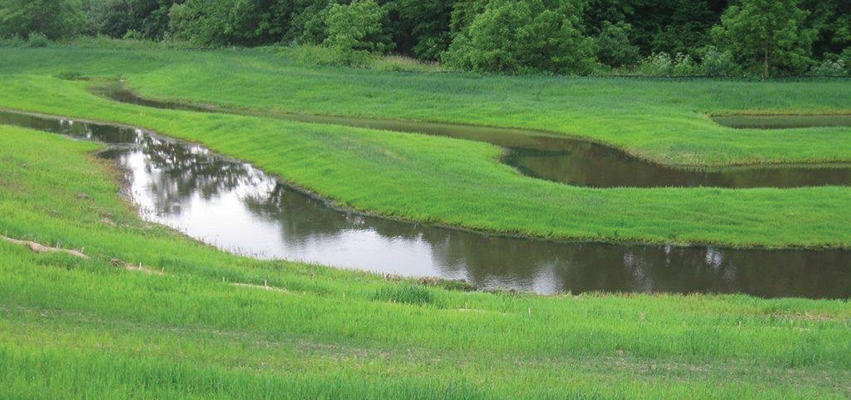Creating a New Wildlife Refuge

A new wetlands project in Tazewell County is coming to life.
On the south side of Indian Creek Landfill near Hopedale, a 1.9-acre wetlands project is now teeming with life. Following its completion in May, ducks, birds, frogs and insects quickly established residency at the new sanctuary. The marshland was constructed by PDC in advance of eliminating 0.65 acres of existing wetland to expand the landfill’s capacity. Under federal and state law, any wetland lost to development must be replaced with a larger one.
“The purpose of the wetland is to mitigate or offset a smaller, existing wetland that had to be removed for landfill development. The replacement effort required extensive permitting through the U.S. Army Corps of Engineers and the Illinois Environmental Protection Agency,” notes PDC Landfill Vice President Ron Welk. “But the effort was worth it. Simply put, our wetland is a really cool thing!”
A Complex Ecosystem
In September 2015, heavy earthmoving equipment cut a shallow contour into the earth. Thick, growing grass is now stabilizing the surface and preventing erosion. During the initial growth phase, the wetland appeared much like a short par-three golf hole after a hard rain.
Water draining from an adjacent farm field feeds the shallow pool, meandering back and forth from the high side of the pool to the low side. The pool is designed to handle 100,000 gallons of flow each day. After passing through the wetland for 48 hours, water molecules are purified.
“When fully established, the wetland naturally cleans water,” explains PDC Tech Services Senior Program Manager Charles Hostetler. “Plants thriving in the wetland, like lily pads and cattail, naturally filter water.
“Living creatures in the small ecosystem feed off each other,” Hostetler continues. “There is a great transfer of energy—a wetland has a bigger transfer of energy than any other ecosystem on earth. The water is purified by the plants that thrive in wet soil. It also supplies a habitat for fish, which eat bugs. Birds are drawn to the neighborhood and eat the bugs. It is a complex circle of life. What’s really exciting to me is a new wetland like this coming to life so quickly.”
Foresight and Care
Two years ago, Hostetler took a job at PDC and moved back to central Illinois, his boyhood home, after decades working out West. He estimates that he built 100 wetlands during his career as a geologist in the state of Washington—work that was driven by residential housing and golf course development.
“Benton and Franklin counties in Washington State are desert climates. When you only get six inches of rain a year, it takes 15 years for a new ecosystem to establish,” he notes. “The Indian Creek wetland is exciting because it’ll be fully functional in one year, thanks to the central Illinois weather. I believe fish will be swimming in the pool in less than five years… Fish eggs from nearby ponds and lakes will stick to birds. The birds will fly to this location, and the eggs will drop into the wetland. Next thing you know, we’ll have a school of fish.”
The wetland is designed to be fluid, unlike a swamp or bathtub where water is stagnant. Water is always moving slowly in and out of the wetland to keep the ecosystem vibrant. A weir constructed in an outlet structure (similar to a manhole) on the low side of the pool regulates water levels, prevents flooding and ensures against drought. Eventually, a sediment basin above the wetland will be constructed to ensure against long-term drought.
Butting up against the Indian Creek wetland are six acres of native timber set aside during the permitting process for bat nesting. Its thick trees offer a perfect sanctuary for bats to thrive—including the Indiana long-eared bat, a federally endangered species. “The Indiana long-eared bat needs habitat space,” says Hostetler. “The bats are important in helping regulate the insect population.
“There is always more diversity needed in the ecosystem,” he adds. “The Coulters [PDC owners and operators] built a bigger wetland than required. I think it shows great foresight and care for our environment.” iBi
Eric Shangraw is Municipal Marketing & Communications Manager for PDC Services, Inc., Area Disposal Service, Inc. and Area Recycling, Inc. For more information, visit www.pdcarea.com.

